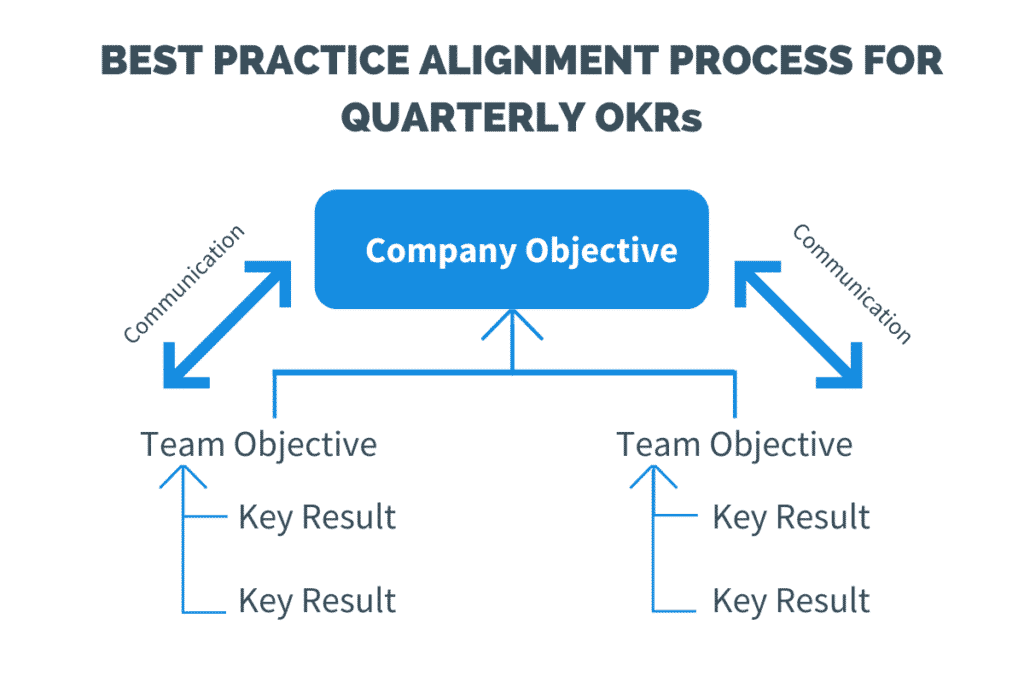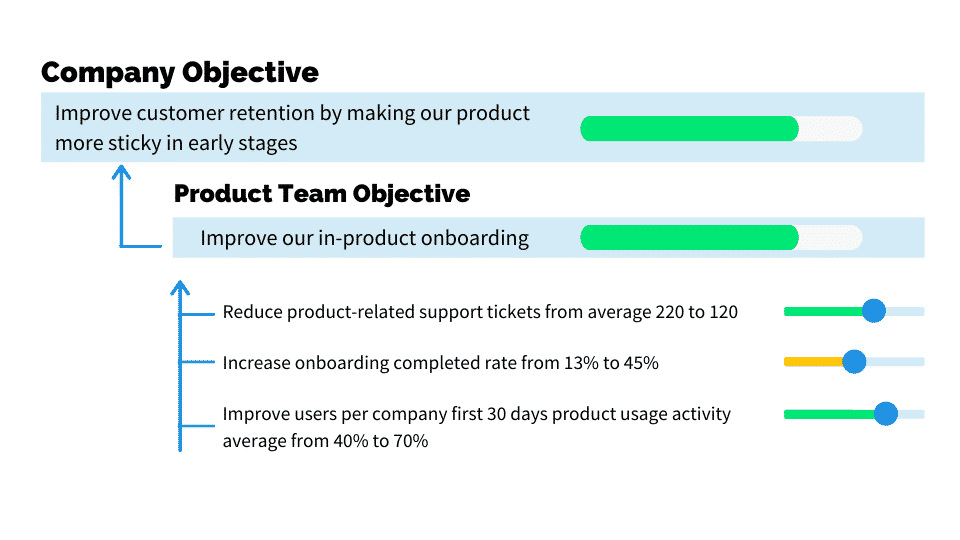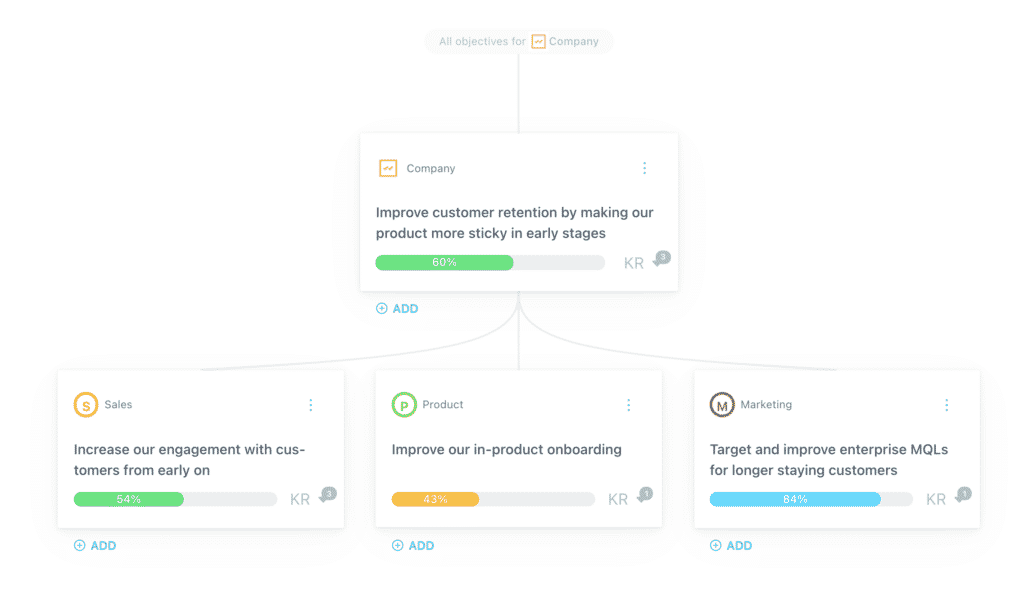One of the biggest benefits of the OKR goal-setting methodology is that it provides strategic goal alignment across your company: from the high-level overarching Company Objectives to Team OKRs and individual deliverables.
We will introduce you to the best and most successful way to align goals. It is a combination of two approaches: top-down and bottom-up.

Step 1: Set overarching Company Objectives
When you want to achieve alignment, you should always start by setting the overarching Objectives on the Company level. It’s impossible to have a company-wide alignment if you do not have a central focus.
Company Overarching Objectives are high-level improvement areas that multiple teams in the company can work on. Those Objectives set guidelines for the teams defining what kind of bigger issue they are supposed to solve with their own Team OKRs.
Company Objectives are usually set by the management team but it’s important to get input and feedback from the teams in the company. Objectives are set quarterly while they should still align with company annual goals or longer-term strategy. Thinking about problems to solve or opportunities to leverage to move closer to the longer-term goals is a good starting point for quarterly Company Objectives.
On the company level, you should only define an Objective or, if needed, multiple Objectives. There is no need to add measurable KRs because Team OKRs will become “Key Results” that drive the Company Objective forward.
Step 2: Communicate the Quarterly Objectives with the teams
Company Objective(s) should be shared and communicated to the teams in the company. Besides sharing the Objective itself, management should also take time to explain why this focus area is important or what kind of problem it helps to solve for the company.
This step is crucial because when people do not understand or do not agree with the overarching Objectives, it’s actually pretty hard to get teams and individuals aligned and working together.
Leave room for discussion and feedback. Team managers might see the situation from a different angle. If they do not agree with the focus area, take time to understand why: maybe there is a really good reason. Do not move forward before everyone has agreed to pursue those Objectives.
Step 3: Teams set their contributing OKRs
After the Company Objectives are agreed on, it’s time for teams to set their OKRs.
Team leaders need to think about how their teams could contribute to the Company’s Objective. What kind of possible team improvement areas do they see to move the Company Objective forward?
Team level OKRs are set with the whole team participating in the process, it shouldn’t be just the manager setting the goals without any input or feedback from the team members.
Alignment doesn’t only mean team and company Objectives being aligned. Alignment is a process that includes everybody. Successful alignment is achieved only when all the stakeholders agree and understand the purpose and meaning of the goals set.
After the team has agreed on the focus areas of their Objectives, it is time to set Key Results to measure progress towards those Objectives.
Learn about how to brainstorm good team Objectives and how to set measurable Key Results.
💻 We recommend using the Weekdone Best Practice OKR drafting template on Miro.
Step 4: Share, agree, and keep aligning
Share the team OKRs with everyone else and link them to the Company Objectives. Of course, there might be occasions where Team OKRs need some discussions and explanations for the management as well. It’s a two-way street.
Management should have an overview of all of the OKRs set. Even though it’s crucial that teams should decide on their goals, it’s also important that different Team OKRs work in parallel and not against each other.
Alignment doesn’t stop at linking the goals together. Alignment is a process that continues through the quarter. One thing is to set OKRs that seem to be aligned and the other thing is to execute, analyze and share the learnings to see how things actually align. That’s what the best practice process is for.
Learn about best practices: Weekly Team OKR Check-ins and company retrospectives.
Step-by-step example
Let’s learn how to align your company through an example story:
Imagine that you have a software-as-a-service (SaaS) company that has been struggling with achieving revenue targets.
After management examined the problem more closely, you reached a conclusion that the revenue is low because of high customer churn. It indicates that there’s some kind of problem you need to solve. After some discussions, management agreed that the problem is that the product doesn’t engage users early on. User activity levels go down quite quickly after the first entry.
Step 1: Management sets the Objective for the company – “Improve customer retention by making our product more sticky in early stages”.
Step 2: Management shares the Company Objective and explains it to the teams. Management includes some stats and a dashboard to indicate where the problem is clearly visible. Teams have some time to get back with questions or feedback on the Objective.
Step 3: Teams set their contributing OKRs. The Product team starts to brainstorm on how they could contribute to making the product sticky early on.
As a result of the brainstorming sessions, they understand that the software onboarding feature is not good enough. Data shows that only 13% of customers are completing the onboarding steps. A high amount of support tickets asking about the product features also indicates that people need more product guidance. If a product is confusing to use, it’s the opposite of being sticky.
Alignment between company and product team OKRs would look like this:

Following the same flow, teams that can contribute to that Company Objective should set, agree, add, and link their goals.
Step 4: Teams share, agree, and prepare to work on the OKRs. After all the teams have set up their OKRs and aligned them with the Company Objective in Weekdone, an OKR hierarchy is created:

Alignment FAQs
What if we have more than 2 levels for OKRs?
It doesn’t actually matter how many levels you have in your organization’s structure. Alignment logic stays the same. The actual work is done by the teams, and higher-level Objectives are there to make sure that there is a unified focus area!
Also, having too many levels of goals might easily overcomplicate the whole process and it might mean lower chances of success. So think it through: do you really need this much complexity or not? Especially, when you are just starting with OKRs, we would strongly recommend keeping it as simple as possible. This means sticking to just 2 levels for your Objectives: Company and Team.
A Department in Weekdone is a team of teams, and it’s a level between the Company and the Team. If you need to set Department level goals (in order to be more specific about the focus areas for several teams), then you should still do this after setting and communicating company goals (steps 1 & 2). Once the Department agrees on their top priority for the quarter (we recommend setting Objectives only), the teams can continue with setting their OKRs and align them with the Department level (steps 3 & 4). You should be careful when setting Key Results on the Department level because there’s a high chance of them ending up being actually KPI/Metrics targets.
Most common alignment challenges

-1- Cascading OKRs instead of aligning them
Management should not set or cascade the focus areas for the teams. This is a red flag for many reasons. First, when something is cascaded down from management, there’s a high chance that it’s a KPI target or a project but not an actual OKR. Secondly, even though management has a good overview of all of the team’s work, they have less knowledge about each team’s specifics and all of the small challenges inside the team. OKRs are more about team-specific things while the general performance is measured by KPIs (which management might set).
Learn more about Measurable Key Results and OKRs vs KPIs.
-2- Management lack of trust in teams or team’s lack of responsibility
In organizations where everything is under command-and-control management might have a hard time trusting the teams to make good decisions. Lack of trust, micromanagement or irresponsible people can also mean that teams do not want to take ownership of their goals. If people cannot or will not be trusted, it’s not the OKRs fault, it’s a cultural issue that management needs to address.
Companies should use KPIs as a way to set expectations for the team’s performance and leave OKRs for them to practice problem-solving thinking and to improve the team.
Don’t take away the team’s chance to put their heads together to understand what they really need and could bring to the table. If leaders set OKRs for everyone, teams can come up with a hundred excuses why they cannot take responsibility for their own results.
-3- Not setting Company level Objectives or not setting good ones
How can teams align if there’s no common direction in the first place? If each team sets their OKRs separately, they might even end up working against each other. OKRs work best if there is alignment and unity in what the teams do.
Company Objectives also have to be good – broad enough to be relevant to many teams and narrow enough to still help the focus. For example, “Increase revenue” is a terrible Objective as it gives no direction. It’s too broad and just says that you need to make more money. But how? That is the question the Objective should answer.
